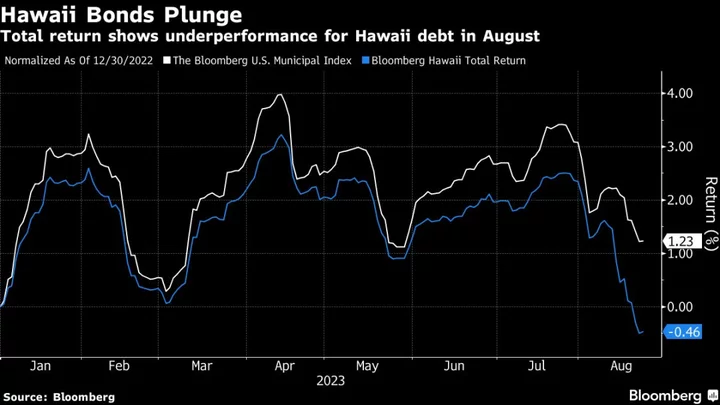Hawaii state and local municipal bonds have surrendered all their 2023 gains in the past three weeks after the deadly Maui wildfires delivered a fresh reminder of climate risk in the $4 trillion market for state and local debt.
An index comprised of Hawaiian municipal securities has dropped 2.81% in August, the worst performance of any state and compared to a 1.8% loss for the broader market, according to data compiled by Bloomberg. Hawaii is one of only four states to post a negative performance this year. At the end of July, its municipal bonds were sporting a more than 2% gain for 2023.
“The Hawaii index was impacted by the large drop of bonds associated with the Maui catastrophe,” said Tom Doe, president and founder of Municipal Market Analytics.
Municipal bonds guaranteed by Hawaiian Electric Co. Inc, the utility under scrutiny for its possible role in the fires, had plunged as much as 40%, according to data compiled by Bloomberg.
Doe said that that drop and the subsequent impact on the broader state index “exemplifies how reactive rather than proactive the market behaves relative to climate risks.”
Climate risk has become increasingly prevalent in the municipal bond market, where states and cities raise money for infrastructure projects like schools, roads and bridges. The debt can often mature in decades, raising the risk that certain certain geographies become more susceptible to extreme weather events.
“Some of those bonds are down by almost 20 points since the beginning of the month due to credit concerns and public rating downgrades to non-investment grade,” said Terry Goode, senior portfolio manager at Allspring Global Investments. “That is one of the main reasons for the index being down this month.”
Goode also noted that the Hawaiian Electric bonds are a small part of the state index and the performance is also impacted by the macro-rate environment and decline in bond prices broadly. The index contains debt sold by a variety of Hawaii issuers like airports, municipalities and universities.
Sizable Cushion
The state is currently assessing the wildfire damage and evaluating the wide-ranging impact the event will have on its property and citizens. The long-term implications of the fires for Hawaii’s and Maui’s economies remains unclear, but the state is well-positioned to respond to immediate financial concerns, according to a Wednesday report by S&P Global Ratings.
Entering the 2024 fiscal year, Hawaii had about $2 billion of reserves - a sizable cushion to provide short-term support and offset revenue losses from stalled economic activity, analysts wrote in the report.
Fitch Ratings affirmed the state’s AA rating and stable outlook on Thursday, citing Hawaii’s solid revenue growth prospects, high independent revenue-raising ability and ability to control spending. The ratings company said that the scope of damage from the fires is still in flux and will likely be “substantial.”
“As with disasters in other states, Fitch anticipates state and local funds will likely be drawn on initially, with federal emergency aid and insurance proceeds playing an important role in longer-term recovery efforts,” the company wrote. “Hawaii’s sizable cash balances provide strong liquidity and disaster response and rebuilding may alter some current spending plans.”
“The state is healthy,” said Clare Pickering, a director of municipal strategy and research at Barclays. “They’ve got reserves, they’ve had a good recovery.”
--With assistance from Amanda Albright.

